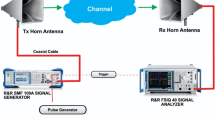Abstract
This paper presents 28 GHz path loss model based on cluster obtained from channel measurement campaigns with rotating platforms and directional antennas in the indoor and outdoor environments. The transmitter (TX) and receiver (RX) both sweep a large range of angles in the azimuth and elevation plane on account of covering main propagation paths and measuring burden. As the sequence number of cluster increases, the path loss exponents (PLEs) increase while shadow factors also have a growing tendency. The PLE of all-clusters is the least because of multi propagation paths, and the LOS PLEs of corridor scenario are less compared with that of office scenario because of corridor’s long and narrow structure. This improved model not only considers cluster characteristics, but also unites directional and omnidirectional models into the same framework, which to some extent improves the 5G mmWave channel model.
Similar content being viewed by others
References
Heath R W. Millimeter wave: the future of commercial wireless systems. In: Proceedings of IEEE Compound Semiconductor Integrated Circuit Symposium (CSICS), Austin, 2016. 1–4
Venugopal K, Heath R W. Millimeter wave networked wearables in dense indoor environments. IEEE Access, 2016, 4: 1205–1221
Song H, Fang X M, Fang Y G. Millimeter-wave network architectures for future high-speed railway communications: challenges and solutions. IEEE Wirel Commun, 2016, 23: 114–122
Xiao Z Y, Xia P F, Xia X G. Enabling UAV cellular with millimeter-wave communication: potentials and approaches. IEEE Commun Mag, 2016, 54: 66–73
Rappaport T S, Sun S, Mayzus R, et al. Millimeter wave mobile communications for 5G cellular: it will work! IEEE Access, 2013, 1: 335–349
Thornburg A, Bai T Y, Heath R W. Performance analysis of outdoor mmWave Ad Hoc networks. IEEE Trans Signal Process, 2016, 64: 4065–4079
Rangan S, Rappaport T S, Erkip E. Millimeter-wave cellular wireless networks: potentials and challenges. Proc IEEE, 2014, 102: 366–385
Schiavoni A, Leoni A, Arena D, et al. Ray tracing simulations at millimeter waves in different indoor and outdoor scenarios. In: Proceedings of 10th European Conference on Antennas and Propagation (EuCAP), Davos, 2016. 1–5
Hur S, Baek S, Kim B, et al. Proposal on millimeter-wave channel modeling for 5G cellular system. IEEE J Sel Top Signal Process, 2016, 10: 454–469
Maccartney R G, Rappaport T S, Sun S, et al. Indoor office wideband millimeter-wave propagation measurements and channel models at 28 and 73 GHz for ultra-dense 5G wireless networks. IEEE Access, 2015, 3: 2388–2424
Sun S, Rappaport T S, Thomas T A, et al. A preliminary 3D mm wave indoor office channel model. In: Proceedings of International Conference on Computing, Networking and Communications (ICNC), Garden Grove, 2015. 26–31
Wang J Y. Beam codebook based beamforming protocol for multi-Gbps millimeter-wave WPAN systems. IEEE J Sel Areas Commun, 2009, 27: 1390–1399
Zhou L, Xiao L M, Li J H, et al. Path loss model based on cluster at 28GHz in the office and corridor environments. In: Proceedings of IEEE 84th Vehicular Technology Conference (VTC-Fall), Montréal, 2016. 1–5
Fleury B H, Tschudin M, Heddergott R, et al. Channel parameter estimation in mobile radio environments using the SAGE algorithm. IEEE J Sel Areas Commun, 1999, 17: 434–450
Fleury B H, Jourdan P, Stucki A. High-resolution channel parameter estimation for MIMO applications using the SAGE algorithm. In: Proceedings of International Zurich Seminar on Broadband Communications, Access, Transmission, Networking, Zurich, 2002. 301–309
Gustafson G, Haneda K, Wyne S, et al. On mmWave multipath clustering and channel modeling. IEEE Trans Antennas Propag, 2014, 62: 1445–1455
Krishna K, Murty M N. Genetic K-means algorithm. IEEE Trans Syst Man Cybern, 1999, 29: 433–439
Czink N, Cera P, Salo J, et al. A framework for automatic clustering of parametric MIMO channel data including path powers. In: Proceedings of IEEE 64th Vehicular Technology Conference (VTC-Fall), Montréal, 2006. 1–5
MacCartney G R, Zhang J H, Nie S, et al. Path loss models for 5G millimeter wave propagation channels in urban microcells. In: Proceedings of IEEE Global Communication Conference (GLOBECOM), Atlanta, 2013. 3948–3953
Rappaport T S, MacCartney G R, Samimi M K, et al. Wideband millimeter-wave propagation measurements and channel models for future wireless communication system design. IEEE Trans Commun, 2015, 63: 3029–3056
Acknowledgments
This paper was supported by National Basic Research Program of China (973) (Grant No. 2012CB316002), National High-tech R&D Program of China (863) (Grant No. 2015AA01A701), National Natural Science Foundation of China (Grant No. 61201192), Science Foundation for Creative Research Group of NSFC (Grant No. 61321061), National S&T Major Project (Grant No. 2017ZX03001011), MOST “Hongkong, Macau and Taiwan” Science Collaboration Project (Grant No. 2014AA01A707), Tsinghua-Qualcomm Joint Project.
Author information
Authors and Affiliations
Corresponding author
Rights and permissions
About this article
Cite this article
Zhou, L., Xiao, L., Yang, Z. et al. Path loss model based on cluster at 28 GHz in the indoor and outdoor environments. Sci. China Inf. Sci. 60, 080302 (2017). https://doi.org/10.1007/s11432-017-9127-6
Received:
Accepted:
Published:
DOI: https://doi.org/10.1007/s11432-017-9127-6




